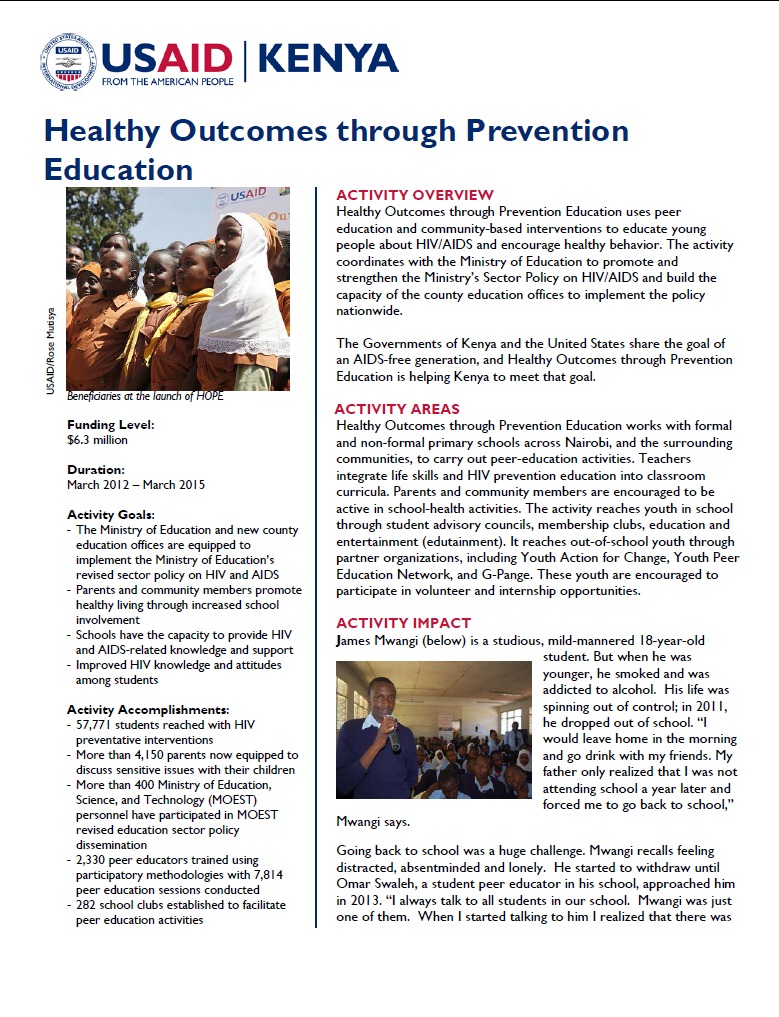Speeches Shim
Funding Level:
US $6.3 million
Duration:
March 2012 – March 2015
Activity Goals:
- The Ministry of Education and new county education offices are equipped to implement the Ministry of Education’s revised sector policy on HIV and AIDS
- Parents and community members promote healthy living through increased school involvement
- Schools have the capacity to provide HIV and AIDS-related knowledge and support
- Improved HIV knowledge and attitudes among students
Activity Accomplishments:
- 57,771 students reached with HIV preventative interventions
- More than 4,150 parents now equipped to discuss sensitive issues with their children
- More than 400 Ministry of Education, Science, and Technology (MOEST) personnel have participated in MOEST revised education sector policy dissemination
- 2,330 peer educators trained using participatory methodologies with 7,814 peer education sessions conducted
- 282 school clubs established to facilitate peer education activities
Key Partners:
Ministry of Education Science and Technology and Ministry of Health, which includes the Kenya Institute of Curriculum Development and the Teacher Service Commission.
Other partners include:
- Global Communities
-
National Organization for Peer Educators
Saint John’s Community Center - Kenya Girl Guides Association
- Support for Addictions Prevention and Treatment in Africa
Activity Location:
Nairobi
ACTIVITY OVERVIEW
Healthy Outcomes through Prevention Education uses peer education and community-based interventions to educate young people about HIV/AIDS and encourage healthy behavior. The activity coordinates with the Ministry of Education to promote and strengthen the Ministry’s Sector Policy on HIV/AIDS and build the capacity of the County Education Offices to implement the policy nationwide.
The Governments of Kenya and the United States share the goal of an AIDS-free generation, and Healthy Outcomes through Prevention Education is helping Kenya to meet that goal.
ACTIVITY AREAS
Healthy Outcomes through Prevention Education works with formal and non-formal primary schools across Nairobi, and the surrounding communities, to carry out peer-education activities. Teachers integrate life skills and HIV prevention education into the classroom curricula. Parents and community members are encouraged to be active in school-health activities. The project reaches youth in school through student advisory councils, membership clubs, education and entertainment (edutainment), debate, award schemes, holiday events, talents shows and sports. The activity helps reach out-of-school youth through partner organizations, including Youth Action for Change, Youth Peer Education Network, and G-Pange. These youth are encouraged to participate in volunteer and internship opportunities.
ACTIVITY IMPACT
James Mwangi is a studious, mild-mannered 18-year-old student. But when he was younger, he smoked and was addicted to alcohol. His life was spinning out of control; in 2011, he dropped out of school. “I would leave home in the morning and go drink with my friends. My father only realized that I was not attending school a year later and forced me to go back to school,” Mwangi says.
Going back to school was a huge challenge. Mwangi recalls feeling distracted, absentminded and lonely. He started to withdraw until Omar Swaleh, a student peer educator in his school, approached him in 2013. “I always talk to all students in our school. Mwangi was just one of them. When I started talking to him I realized that there was something wrong,” Swaleh says. Swaleh is one of the peer educators trained under the USAID Healthy Outcome through Prevention Education program, which promotes healthy behaviors to prevent the spread of HIV and alcohol and substance abuse among students.
According to Mwangi, Swaleh came into his life when he needed support. “Swaleh is the friend I never had, but wished I had. He talked to me, listened to me, provided me with reading materials on drugs and substance abuse and helped me understand the risks I was exposing myself to,” Mwangi says. “He got me to believe I could change.”
Mwangi is keen to mention that his turnaround was not without challenges. He experienced withdrawal symptoms that could have easily dragged him back to his old ways if it were not for Swaleh. “Swaleh was always by my side, encouraging me to endure the pain. He would check up on me even during weekends. He was so committed and focused on getting me back on the right track. He told me to call him anytime I felt like I was about to make a bad decision,” Mwangi says.
Mwangi also had the support of his father. “I have a wonderful relationship with my father, we talk a lot and he is proud of me. Without him and Swaleh, I would have gone back to my old ways,” says Mwangi.
He is now a popular student in his school. His teachers have provided extra support that has helped him improve his grades. He is happy about the decisions he has made and acknowledges that his choices saved his life. “I am more aware and cautious of my actions. I want to concentrate on my studies and prepare for my final exams later this year.”
“I am who I am today because one person decided to help me become a better person,” Mwangi declares. “My future is bright and I also thank God, Swaleh, my father and teachers for their support,” he adds.
USAID Contact:
Irene Muriuki, Activity Manager
USAID/Kenya
Office of Education and Youth
Tel: +254 20 862 2000
Email: imuriuki@usaid.gov
Healthy Outcomes through Prevention Education Contact:
Betty Adera, Chief of Party
CHF International Kenya
Tel: +254 (20) 210 1312/3
Email: badera@chfkenya.org
Website: http://www.globalcommunities.org/kenya
Updated August 2014


Comment
Make a general inquiry or suggest an improvement.